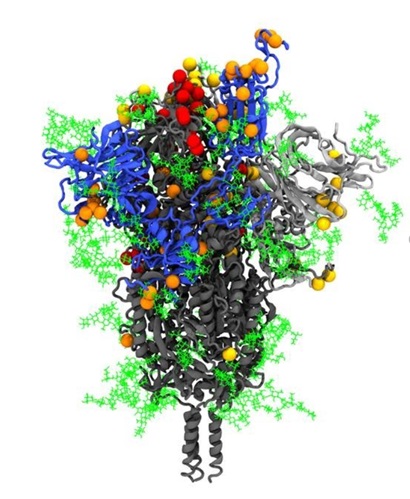CSIRO Special Health Advisor Dr Rob Grenfell said:
Variant emergence
“It’s expected the coronavirus will self-select for strains that will counter our efforts to control it. That means more infectious strains are likely to come out. This is because we’ve been trying to avoid the spread through our public health measures, like lockdowns and mask-wearing.
“It’s also anticipated a variant may emerge in the future that will have some degree of resistance against the current vaccines. This risk could be reduced if we have an effective global vaccine operation.
The pandemic will not end until all countries have achieved high levels of vaccination.”
What is known about Omicron so far
“The Omicron variant emerged in southern Africa sometime in early November. It has a multitude of mutations which make it a variant of concern, because those mutations alter the spike protein. The spike protein is important to the virus because it’s the way that it binds to our respiratory cells to infect us. It’s this protein that the vaccines target.
“Omicron has also been detected in people who have had COVID-19 previously.
“At this stage the cases detected seem to have had mild disease. However, the virus is now rapidly becoming the most common variant in southern Africa and has already seeded across many other countries in the world.
“It appears that this variant could be more infectious than the dominant Delta strain.
“The severity of this virus, as compared to Delta, is unknown at this time. Researchers will be closely following the people who contract Omicron and monitoring how ill they get.
“Even if it is less severe than Delta, this is a numbers game – if many people get infected, even with a low hospitalisation rate, it still means a lot of people ending up in hospital.”
Effectiveness of vaccines against Omicron
“At this stage, we expect the vaccines will still prevent serious illness from Omicron. Studies are kicking off to determine if antibodies generated by vaccination or infection neutralise this virus, and we should see some results in the next week.
“Scientists have created several platforms for vaccines against coronaviruses during this pandemic that are very effective and safe, and these can be modified to adjust for variants. Already, Oxford (AstraZeneca), Pfizer and Moderna are looking at ways to modify their vaccines if necessary.
“Australian authorities are reviewing booster shot timeframes to see whether they should be brought forward to better protect against Omicron. Until that review is finished, you should get your booster shot as soon as you’re eligible, which is currently six months after your second vaccine dose.
“While there’s still a lot to learn about Omicron, scientists have been working all through the pandemic to develop additional tools in our line of defence against the pandemic that will continue to be useful here. For example, CSIRO scientists, working with Qantas and the University of Queensland, showed that wastewater testing on international flights can – providing valuable data for public health agencies.”
CSIRO scientist and COVID-19 expert Dr Seshadri Vasan said:

“The latest variant of concern, Omicron, has been reported in many countries including Australia.
“Of the 5.6 million coronavirus sequences on the world’s largest repository, ‘GISAID’, 182 are Omicron as of 30 November 2021 (5am Geneva time). 68% of these sequences are from samples collected on or after 9 November in South Africa. Of the remaining, 19 are from Botswana, 12 are from the Netherlands, five each from Australia (4 New South Wales; 1 Northern Territory) and Hong Kong, four each from England and Italy, two from Canada, and one each from Austria, Belgium, Czech Republic, Germany, Israel, Réunion, and Spain.
“In addition to these 15 countries, confirmed cases have been reported in several others, but the sequences have not yet been uploaded to GISAID.
“As this variant of concern currently has a reproduction number above the threshold of 1 required to spread (preliminary reports place it between 1.3 and 1.6), and this variant contains several mutations in regions where antibody binding is known to occur, there could be potential for this virus to evade existing immunity provided by current vaccines.
“This variant has a constellation of 34 mutations in the spike protein that has the receptor binding domain. Several of these mutations we have encountered previously, for instance, the 69-70 deletion present in Alpha; the K417N found in Beta and Gamma; the N501Y common to Alpha, Beta and Gamma; and the T478K seen in Delta. We are also studying new mutations, such as E484A and G496S, and their interplay with the others.
“We need to study these changes in combination, not just rely on the fact that many have occurred previously, in individual variants. We cannot predict the variant’s impact on the efficacy of vaccines and therapeutics unless we test them experimentally and this will take us to early 2022 to get the full picture. It will require a global effort and we have been collaborating with our Australian, South African and other partners to play our part in combating this virus as it evolves. CSIRO’s biomolecular modelling and bioinformatics teams are supporting these efforts, which are led from our Australian Centre for Disease Preparedness.
“We are continuing to support global ‘vaccine matching’ efforts, which involves tweaking the vaccines so they protect against a new variant of concern. In the meantime, those who are double or triple vaccinated can still expect some level of protection, so it is important to achieve high vaccination coverage and follow sensible precautions such as masks, social distancing, and meeting virtually or outdoors rather than in confined spaces.”








